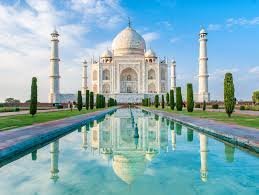The Taj Mahal, one of the New Seven Wonders of the World, stands as an architectural masterpiece and a symbol of eternal love. Located in Agra, India, this ivory-white marble mausoleum was built by Mughal Emperor Shah Jahan in memory of his beloved wife, Mumtaz Mahal. Renowned for its breathtaking beauty, intricate craftsmanship, and historical significance, the Taj Mahal is one of the most visited and photographed monuments in the world. This article explores its history, architecture, significance, and fascinating facts.
The History of the Taj Mahal
The construction of the Taj Mahal began in 1632 after the death of Mumtaz Mahal, the favorite wife of Shah Jahan. She passed away while giving birth to their 14th child, and the emperor, grief-stricken, decided to build a grand mausoleum as a tribute to her.
It took around 22 years and over 20,000 artisans and craftsmen to complete this architectural wonder. The Taj Mahal was completed in 1653, with materials sourced from India, Persia, and beyond. However, soon after its completion, Shah Jahan was overthrown by his son, Aurangzeb, and spent the rest of his life in captivity at Agra Fort, gazing at the Taj Mahal until his death in 1666. His remains were later placed beside Mumtaz Mahal in the Taj Mahal.
Architectural Marvel of the Taj Mahal
The Taj Mahal is an outstanding example of Mughal architecture, blending Persian, Indian, and Islamic styles. Some of its most notable features include:
1. The Majestic White Marble Structure
- Built using pristine white marble, sourced from Makrana, Rajasthan.
- Shimmers in different hues throughout the day: pinkish at sunrise, dazzling white at noon, and golden at sunset.
2. The Grand Central Dome
- The central dome rises to a height of 73 meters (240 feet), symbolizing heaven.
- It is flanked by four smaller domes, adding to its symmetry and grandeur.
3. The Four Minarets
- Standing at 40 meters (131 feet) each, these minarets lean slightly outward to protect the main tomb in case of collapse.
- Serve as a structural safety feature against earthquakes.
4. Intricate Calligraphy and Inlay Work
- Features exquisite calligraphy of Quranic verses, inscribed by skilled Persian calligraphers.
- Inlaid with precious and semi-precious stones like jade, turquoise, and onyx.
5. The Charbagh Gardens
- A perfectly symmetrical Persian-style garden, divided into four sections representing paradise.
- Symbolizes the Islamic concept of Jannat (heaven).
Why the Taj Mahal is Significant
The Taj Mahal is not just an architectural wonder; it holds immense historical and cultural importance:
- A Symbol of Love – Built as a tribute to eternal love, the Taj Mahal represents devotion and loss.
- A UNESCO World Heritage Site – Recognized in 1983, it is a masterpiece of world heritage.
- An Architectural Wonder – Showcases advanced Mughal engineering, symmetry, and craftsmanship.
- A Major Tourist Attraction – Welcomes over 7-8 million visitors annually, making it one of the most visited landmarks in India.
How to Visit the Taj Mahal
The Taj Mahal is located on the banks of the Yamuna River in Agra, Uttar Pradesh, India.
1. Best Time to Visit
- The best time to visit is October to March, when the weather is cooler.
- Early morning or full moon nights offer the best views of the Taj Mahal.
2. How to Get There
- By Air – The nearest airport is Agra Airport (Kheria Airport).
- By Train – Agra is well-connected by Shatabdi and Gatimaan Express trains.
- By Road – Well-linked to Delhi (3-4 hours drive via Yamuna Expressway).
3. Ticket Information
- Separate entry fees for Indian and international tourists.
- Additional charges apply for visiting the main mausoleum.
- Online booking and guided tours are recommended to avoid long queues.
Interesting Facts About the Taj Mahal
- The Taj Mahal took over 1,000 elephants to transport construction materials.
- The inlay work consists of 28 different types of gemstones.
- Myth: Shah Jahan planned a black Taj Mahal, but historians dispute this.
- The structure has survived several earthquakes, wars, and pollution threats.
- The Taj Mahal changes colors depending on the time of day and weather conditions.
Challenges in Preservation
Despite its grandeur, the Taj Mahal faces challenges such as:
- Air Pollution and Acid Rain – Pollution from nearby industries affects the marble’s pristine whiteness.
- Tourist Foot Traffic – Over 7 million visitors annually contribute to wear and tear.
- Riverbank Erosion – The Yamuna River’s receding water levels pose structural risks.
To combat these issues, the Indian government has implemented strict conservation measures, including limited vehicular access and regular cleaning efforts.
Conclusion
The Taj Mahal is a true marvel of Mughal architecture, a monument of love, and a global treasure. Whether you visit for its historical significance, artistic beauty, or romantic allure, the Taj Mahal continues to captivate millions of visitors worldwide.
A trip to the Taj Mahal is more than just sightseeing—it is an experience of timeless beauty, history, and emotion. If you ever visit India, this magnificent wonder should undoubtedly be on your bucket list.


